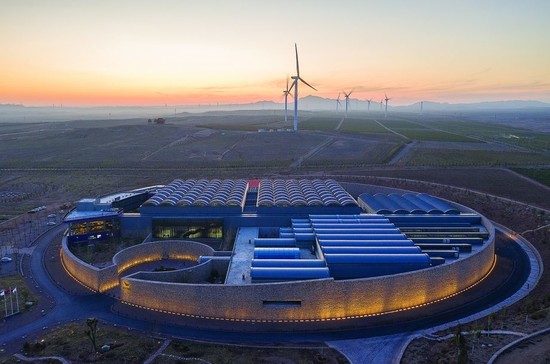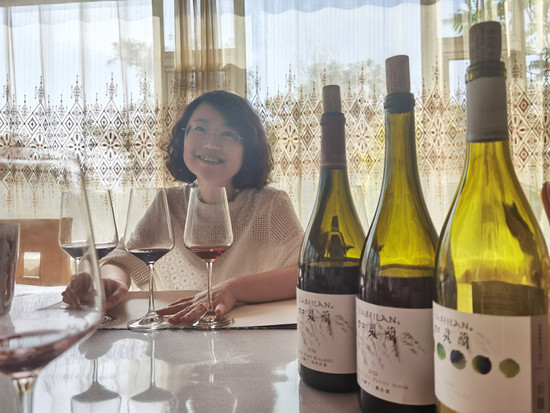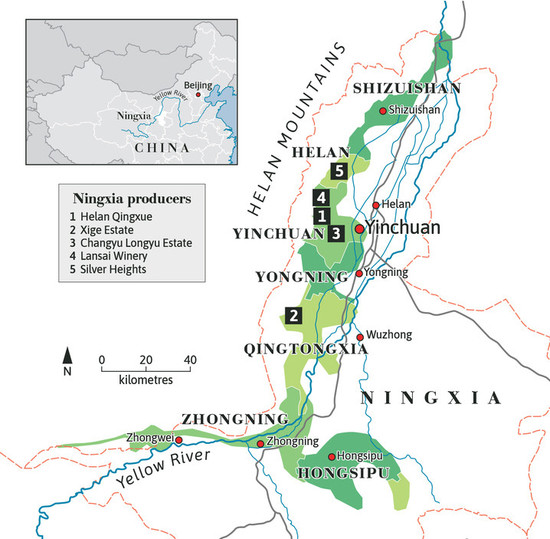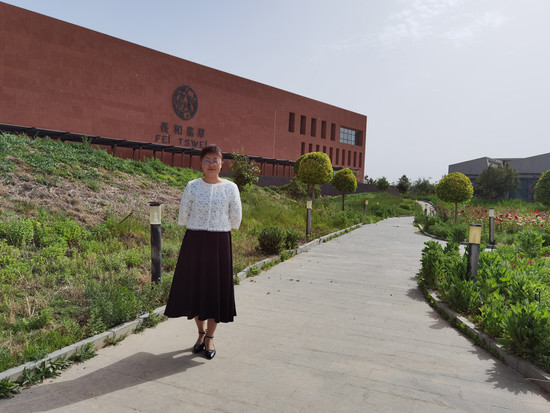Since its unanticipated wine awards success in 2011, Ningxia has emerged as China’s fine wine-producing hotbed. After 13 years of rapid development, what’s next for this desert-fringed region?

Landing in Yinchuan in central-north China back in May, five years after my last visit in 2019, I arrived at an opportune moment just after the drama series The Homeland of Stars had premiered on national television. The popular show, named for Ningxia’s renowned clear night skies, is based on a historical reality – one that’s familiar to many of us in the wine world, but that was life-changing for the pioneers who first planted vines on the eastern foothills of Helan Mountain.

Evolution of a region
The first time Ningxia truly left an impression in the world of wine was in 2011 – in the Decanter World Wine Awards Bordeaux blend category, an obscure producer named Helan Qingxue won the International Trophy (equivalent to today’s Best in Show) with its Jia Bei Lan Grand Reserve 2009. ‘At that time, Ningxia wasn’t even listed as a wine region on the Awards’ entry form,’ recalled Professor Li Demei, wine consultant behind the award-winning wine (people’s names are written in the Chinese format throughout, with surnames first).
There is documented evidence of vines being grown in this area 2,000 years ago, during Zhang Qian’s diplomatic expedition to the West – a mission that first opened up the Silk Road. Yet in the modern context, Ningxia is a young wine region.

In the 1990s, nationwide viticultural research led to efforts to improve the desert-encircled region’s saline-alkaline soils. As a result, in 1998, 3,000ha (45,000 mu) of wine grapes were planted along a strip of barren wasteland between Helan Mountain and the alluvial plain of the Yellow River.
But it was Jia Bei Lan’s win in 2011 that really put the wind beneath the wings of the new region – the unprecedented award at the world’s largest wine competition brought instant attention, domestic and international, to Ningxia’s potential for producing world-class wines.
The following year, Ningxia established its own provincial wine bureau. Then, in 2013, the region created its own wine classification system, following the Bordeaux model. Favourable agricultural and land-use policies combined with immense investments led to large-scale vine planting schemes and ambitious construction projects, making the region what it is today at a jaw-dropping speed.

Between mountain ridge & river
Shielded from Gobi desert sandstorms by the Helan Mountain range, which stretches more than 200km from north to south, Ningxia enjoys 3,100 hours of sunshine per year, while receiving less than 200mm of rain, according to official data. Diurnal temperature variations of up to 15°C help to preserve grape acidity, although many producers still find it necessary to add a touch of acid for freshness. Drip irrigation is encouraged to conserve water, though flood irrigation is welcomed where possible, as it enriches the infertile soils and washes away salt.
Southern sub-regions, such as Hongsipu and Qingtongxia (see map), are cooler than the northerly areas because of their proximity to the Helan Mountain foothills, where chilling air from the desert whistles through. Cooler sandy clay soils (as opposed to the gravelly soils found in the north) also have an impact.
‘By looking at the effective accumulated temperature during the growing season and the annual sunshine hours, you might assume Ningxia to be a warm wine region,’ observes Professor Li, who is involved in multiple winemaking projects in several Chinese wine regions. ‘However, it’s also extremely continental – temperatures increase and drop quickly in spring and autumn. Therefore, you may find early-ripening varieties such as Pinot Noir and Chardonnay, even Riesling, showing warm-climate characters, while late-ripening Cabernet Sauvignon exhibits cool-climate flavours.’
Many producers loosely practise organic farming in this arid region, although late spring frost is a constant threat, especially for vineyards with cooler soils, at lower elevations and further from the mountain, where cold air remains static. To help their vines survive harsh winters during which temperatures can drop below -20°C, growers go through an arduous process of burying their vines and then digging them out each spring, which ups production costs by 30%.

Search for the perfect style
Thanks to improved vineyard management and sorting of fruit in the winery, and the use of the latest winemaking equipment, the ‘jammy-and-green’ characteristics in Ningxia reds are much less common than I experienced five years ago. The young region’s reputation for high alcohol, heavy extraction and excessive use of oak is likely to change next, as there is a general move towards more gentle winemaking and less use of new oak.
Situated at 1,200m altitude in the south, the cooler Hongsipu sub-region may hold the answer in the region’s quest for finesse and natural elegance. Winemaker Li Cai of Huida Sunshine shared with me his inaugural 2013 vintage of Qianhongyu Cabernet Sauvignon, whose combination of captivating natural acidity, vibrant wild berries and refined tannins was stunning.
For the potential red ‘poster grape’ Marselan, producer Huahao prides itself on its robust, oak-infused style, while Chateau Chanson and Silver Heights (silverheights.com.cn) adopt a less extractive approach for greater purity and more delicate aromas. Domaine Pushang sits in between, producing expressions with notes of coconut and spiced dark fruits dipped in chocolate.
Pinot Noir shines in the hands of producers with patience and a gentle touch, such as Helan Qingxue and Lan Sai. Heat-tolerant Rhône varieties, namely Viognier and Syrah, have started to show potential, too, with charming examples crafted by Copower Jade and Mihope. Interestingly, Germany’s red Dornfelder is attracting attention for its fresh acidity and floral aromas; Pushang and Dongfang Yuxing both offer pretty entry-level examples. Chateau Lion has even succeeded in nurturing red and white hybrid varieties – called Prince and Princess, respectively – that do not need to be buried to survive winter.

The challenges & the future
To the disappointment of many, the domestic market didn’t rebound immediately after China abolished travel restrictions at the end of 2022. ‘Diversity’ therefore became the keyword, as producers paid much more attention to consumer demands.
One example is sparkling producer Chandon (lvmh.com) – it developed a highly popular, tangerine peel-flavoured Spritz while working on its first Blanc de Blancs NV for the premium market. For Dongfang Yuxing, winemaker Wu Xiuyong created an impressive fortified wine based on Cabernet Gernischt (a red grape of European origin with a strong genetic link to Carmenère), to appeal to China’s huge spirits-drinking audience.
Meanwhile, post-Covid, foreign consultants are less active on-site – partially due to international travel bans during lockdowns – while local winemaking talents, many of whom have studied abroad, are gaining confidence both in the vineyard and in the cellar. Next-generation owners and young winemakers in their 20s and 30s are getting more involved, bringing fresh ideas to digital marketing and espousing winemaking philosophies that are more in line with the international market.
Pricing, however, remains a hurdle to competing in export markets. Matthew Horsley, buyer at The Wine Society in the UK, believes that there is demand for Chinese wines priced under £20. Yet many entry-level wines from Ningxia already exceed this threshold in their domestic market due to the costs associated with vine burying and high-end equipment.

Marco Milani, CEO of Silver Heights, asserts that it’s through on-trade channels that wines from Ningxia have the best opportunity to be ‘judged without bias’ in the premium sector. Changyu has a long-established presence in the Western market (see xxx), and coming up are Copower Jade, Devo, Kanaan, Silver Heights and Xige, to name a few, which have already secured some initial success.
Just 13 years since it first hit the headlines, the fine wine region deep in the heart of north China has come a long way. Now, after an initial surge of investment and planting of classic varieties such as Cabernet Sauvignon and Merlot, savvy local producers are rapidly shifting their focus towards more diverse styles and varieties. Will the ‘Homeland of Stars’ nurture a new constellation? Don’t look away.
How to get there
Fly to Beijing and transit to Yinchuan. You can hire a local guide (see wineningxia.com), or you can hop on bus tours to take you around the wineries.

Ningxia Helan Mountain East at a glance
Total plantings: 40,000ha*
Main sub-regions north to south: Shizuishan, Helan, Yinchuan, Yongning, Qingtongxia, Hongsipu
Soils: Gravels closer to the hillside, sandy clay in regions closer to the Yellow River
Altitude: Vineyards are above 1,000m up to about 1,200m
Climate: Continental
Total production: 105m litres*
Key grapes:Red Cabernet Sauvignon, Merlot, Marselan, Cabernet Gernischt, Pinot Noir, Malbec, Syrah. White Chardonnay, Welschriesling, Viognier, Riesling, Petit Manseng
[*Source: Ningxia Wine Bureau]
Ningxia recent vintages by Professor Li Demei
2023 (4.5*) An arid vintage, hazard-free with ample sunshine. Good quality, large crop
2022 (4*) Plenty of heat throughout the growing season, especially during summer. Early-ripening varieties suffered, with exceptions in cooler sub-regions
2021 (4*) Sufficient heat with limited rainfall. Overall a good vintage though quality varies between sub-regions
2020 (3*) Severe spring frost and cool temperatures. Late-harvest varieties performed better. Low yields with polarised quality
2019 (5*) Splendid across the whole region. No widespread occurrences of environmental or weather problems, low rainfall with plenty of sunshine
Subscribe to Decanter Premium to discover ten wines to try and five producers to know.
All rights reserved by Future plc. No part of this publication may be reproduced, distributed or transmitted in any form or by any means without the prior written permission of Decanter.
Only Official Media Partners (see About us) of DecanterChina.com may republish part of the content from the site without prior permission under strict Terms & Conditions. Contact china@decanter.com to learn about how to become an Official Media Partner of DecanterChina.com.




Comments
Submit